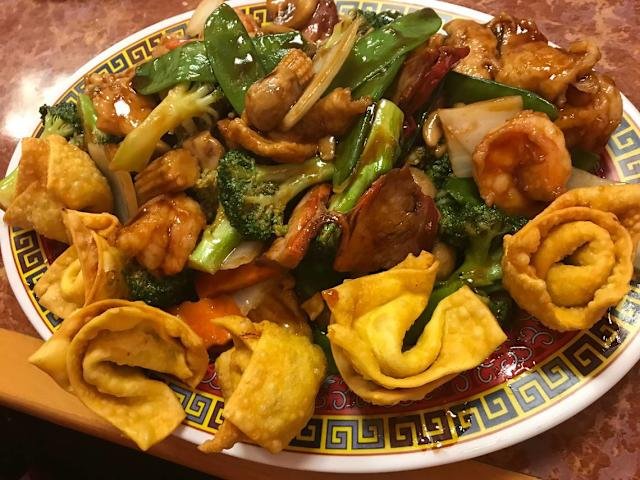Few dishes capture the heart of Chinese American cuisine like subgum wonton. It’s a dish that brings together the best of both worlds the comforting warmth of savory wontons and the lively crunch of fresh vegetables tossed in a glossy, aromatic sauce. Every bite feels like a celebration of flavor and texture, blending tender dumplings, crisp veggies, and rich umami depth in perfect balance.
Whether you’re a food lover exploring new Asian flavors or someone who wants to recreate restaurant favorites at home, this guide will show you everything you need to know from history and ingredients to cooking techniques and creative variations.
What Is Subgum Wonton?
The term “subgum” (pronounced sub gum) comes from the Cantonese word “sap gam,” meaning mixed assortment or everything in it. In Chinese-American cooking, “subgum” describes dishes that include a colorful mix of vegetables and proteins a style that celebrates abundance and variety.
Pair that with wontons, small dumplings filled with seasoned pork, shrimp, or vegetables, and you get subgum wonton a stir fried or saucy dish that’s bursting with layers of flavor. Unlike traditional wonton soup, which is served in broth, subgum wonton focuses on textures: tender wontons meet crunchy vegetables, all bound by a savory sauce.
This fusion dish perfectly reflects the story of Chinese cuisine’s evolution in the West adaptable, inventive, and deeply comforting.
The Origins and History
To understand subgum wonton, you need to look back at the roots of Chinese-American cuisine. In the late 1800s and early 1900s, Chinese immigrants brought Cantonese cooking traditions to cities like San Francisco, Chicago, and New York. However, they adapted recipes to suit local ingredients and American palates.
Out of this adaptation came dishes like chop suey, chow mein, and eventually, subgum variations. The concept was simple create flavorful, filling dishes that incorporated a variety of ingredients. Subgum wonton emerged as a crowd-pleaser because it combined something familiar (dumplings) with something exciting (a vibrant stir-fry).
“Subgum dishes are like a symphony every ingredient plays a part, creating harmony in the bowl.”
Chef Ming Tsai, Chinese-American restaurateur
By the mid-20th century, subgum wonton had found its way into nearly every Chinese-American restaurant menu. Today, it remains a favorite across generations, cherished for its satisfying mix of tastes and textures.
Ingredients That Make Subgum Wonton So Irresistible
The magic of subgum wonton lies in its ingredients a beautiful mix of soft, crispy, and saucy elements that come together seamlessly. Here’s a breakdown of the key components and what makes each one special:
| Ingredient | Purpose | Cooking Tip |
| Wontons | The heart of the dish delicate dumplings filled with savory meat or vegetables. | Use thin wrappers and don’t overfill. |
| Protein (Shrimp, Chicken, Pork, or Tofu) | Adds richness and substance. | Cook separately to avoid overcooking. |
| Mixed Vegetables | Brings crunch, color, and nutrition. | Keep heat high to retain crispness. |
| Aromatic Sauce | The binding element that ties everything together. | Balance soy, oyster sauce, and sesame oil. |
| Garnishes (Scallions, Sesame Seeds, Peanuts) | Add final texture and visual appeal. | Sprinkle right before serving. |
Commonly Used Vegetables
- Snow peas
- Baby corn
- Water chestnuts
- Bamboo shoots
- Bell peppers
- Mushrooms
- Carrots
Each ingredient plays a role the vegetables add freshness, the sauce deepens flavor, and the wontons bring satisfying substance. The result is a dish that feels both light and hearty.
How to Make
Cooking subgum wonton at home might sound intimidating, but it’s actually quite approachable. The key lies in timing, preparation, and high heat. Follow this detailed guide to create a restaurant-quality version in your own kitchen.
Prepare the Wontons
- In a bowl, mix ground pork or shrimp with soy sauce, minced garlic, grated ginger, sesame oil, and a touch of sugar.
- Place a small spoonful of filling in each wonton wrapper. Fold diagonally and seal with water.
- Boil wontons in lightly salted water until they float. Drain and set aside.
Stir Fry the Vegetables
- Heat a wok or deep skillet over high heat.
- Add oil, then stir fry minced garlic and ginger until fragrant.
- Toss in vegetables like snow peas, carrots, bell peppers, and mushrooms.
- Stir-fry quickly for 2–3 minutes they should stay crisp and colorful.
Make the Sauce
Combine in a bowl:
- 2 tablespoons soy sauce
- 1 tablespoon oyster sauce
- ½ cup chicken broth
- 1 teaspoon cornstarch mixed with water
- A drizzle of sesame oil
Pour into the wok and stir until slightly thickened.
Step 4: Combine Everything
Add the cooked wontons and any protein (like chicken or shrimp) into the wok. Toss gently until all ingredients are coated evenly in sauce.
Step 5: Garnish and Serve
Finish with sliced scallions or sesame seeds. Serve hot with steamed rice or noodles.
Pro Tips for Perfect
- Always use high heat to create that smoky “wok hei” flavor.
- Avoid overcooking vegetables; they should stay bright and crisp.
- Don’t drown the dish in sauce aim for a light coating.
- For a crunchier version, use fried wontons instead of boiled.
- Add a spoonful of chili oil or Sriracha for heat.
Nutritional Benefits
Subgum wonton offers a satisfying meal that balances flavor and nutrition. Here’s a rough nutritional profile per serving (about 2 cups):
| Nutrient | Approximate Amount |
| Calories | 400 kcal |
| Protein | 24 g |
| Carbohydrates | 38 g |
| Fat | 14 g |
| Fiber | 5 g |
Because it’s rich in vegetables and lean protein, subgum wonton is lighter than many takeout favorites. You can make it even healthier by:
- Using steamed wontons instead of fried.
- Reducing sodium by choosing low-sodium soy sauce.
- Swapping cornstarch with arrowroot powder for cleaner thickening.
Popular Variations
1. Chicken
A lean and mild version that pairs well with a slightly sweet sauce. Perfect for those who prefer lighter flavors.
2. Shrimp
Seafood lovers adore this take. The shrimp adds a delicate sweetness that elevates the dish’s umami notes.
3. Vegetarian
Replace the meat filling with tofu, mushrooms, or finely chopped vegetables. It’s equally satisfying and full of texture.
4. Crispy
This version uses fried wontons tossed in the signature subgum sauce perfect for when you’re craving crunch.
How to Serve
Subgum wonton is incredibly versatile. You can serve it as a main course, a side dish, or part of a larger Chinese American meal.
Serving Ideas
- Over steamed jasmine rice for a wholesome dinner.
- Alongside egg drop soup or hot and sour soup.
- On top of chow mein noodles for extra substance.
- As part of a family style spread with fried rice and beef with broccoli.
Pair it with green tea or light beer to balance the savory richness.
Subgum Wonton vs. Other Wonton Dishes
| Dish | Main Ingredient | Texture | Serving Style | Flavor Profile |
| Subgum Wonton | Wontons, mixed veggies, protein | Soft + Crunchy | Stir-fry or saucy plate | Savory, umami-rich |
| Wonton Soup | Wontons, broth | Soft | In hot soup | Light, soothing |
| Fried Wontons | Filled wrappers | Crispy | Appetizer | Crunchy, salty |
| Wonton Lo Mein | Wontons, noodles | Chewy | Noodle dish | Hearty, satisfying |
The main difference lies in texture. Subgum wonton offers contrast tender dumplings and crisp veggies in a silky sauce making it more dynamic than the soup or noodle versions.
Common Mistakes
Even seasoned cooks make small missteps with subgum wonton. Here’s what to watch out for:
- Overcrowding the wok causes steaming instead of stir-frying.
- Overcooking vegetables they’ll lose color and crunch.
- Too much sauce leads to soggy wontons.
- Skipping aromatics garlic and ginger define the flavor.
- Thick wonton wrappers they overpower the filling.
Avoiding these pitfalls ensures your dish turns out light, flavorful, and perfectly balanced.
Expert Tips for Restaurant Quality Results
To elevate your subgum wonton from homemade to restaurant-level:
- Use a carbon steel wok it retains heat and adds authentic flavor.
- Prep all ingredients before cooking; stir-frying happens fast.
- Use a mix of oils vegetable for frying, sesame for flavor.
- For shine, add a drop of honey or sugar to the sauce.
- Always serve immediately it loses texture if it sits too long.
Frequently Asked Questions (FAQ)
- What does “subgum” mean?
It translates to “mixed assortment,” referring to a blend of meats and vegetables. - Is subgum wonton spicy?
Not traditionally. However, adding chili oil or crushed red pepper can introduce heat. - Can I freeze subgum wontons?
Yes. Freeze the uncooked wontons on a tray, then transfer to an airtight bag. Boil directly from frozen when ready to use. - What sauce works best?
A combination of light soy sauce, oyster sauce, ginger, and sesame oil delivers that authentic restaurant flavor. - Is it gluten-free?
It can be! Use rice paper wrappers or gluten free wonton skins and tamari instead of soy sauce.
Why Subgum Wonton Deserves a Place on Your Table
Subgum wonton is more than a meal it’s an experience. The way the flavors mingle smoky wok aroma, tender dumplings, bright vegetables tells a story of culture, adaptation, and creativity. Every forkful (or chopstick bite) is a reminder of how food evolves while staying true to its roots.
This dish also fits beautifully into modern home cooking. It’s quick to make, endlessly customizable, and far healthier than takeout if made with fresh ingredients.
“Good food is memory. Subgum wonton carries the warmth of tradition and the joy of discovery.”
Chef Lee Hwa, Culinary Historian
Conclusion
Subgum Wonton stands as a timeless favorite for a reason. It’s colorful, comforting, and irresistibly flavorful a perfect example of how Chinese-American cuisine celebrates diversity on a plate. Whether you prefer the tender bite of steamed wontons or the crunch of fried ones, this dish satisfies every craving.
So next time you’re in the mood for something both familiar and adventurous, skip the takeout menu. Fire up your wok, grab fresh vegetables, and make your own subgum wonton at home. The aromas, flavors, and joy it brings to the table will remind you that the best dishes are often the ones we create ourselves.



